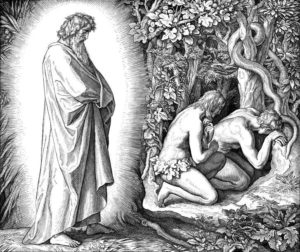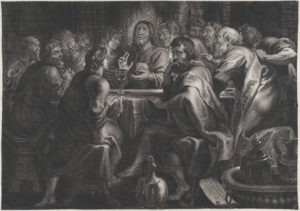Bread – A Mirrored Curse
by Fr. William Rock, FSSP
 In the plan of salvation, God mirrored, as it were, conditions of the Fall in the conditions of the Redemption. At the Fall, there was a man, Adam; a woman, Eve; and a tree with forbidden fruit, the Tree of the Knowledge of Good and Evil (see Gen 3). At the event which merited in a particular way for us our salvation, the Crucifixion, there was a man, Christ, the new Adam (see 1 Cor 15:45); a woman, Mary, seen by the Fathers as the new Eve;1 and a tree, the Cross (e.g., Act 5:30). The link between the Tree of the Knowledge of Good and Evil and the Cross is also expressed in Preface of the Holy Cross – God, You Who “didst establish the salvation of mankind on the tree of the Cross; that whence death came, thence also life might arise again, and that he [the devil], who overcame by the tree, by the tree also might be overcome:” This Preface also illustrates this mirror, as it were, of the Fall and Redemption namely in that God utilized what the Devil used to doom man, a tree, to overcome the Devil. It was by a tree that death came to man, and from a tree, life returns.
In the plan of salvation, God mirrored, as it were, conditions of the Fall in the conditions of the Redemption. At the Fall, there was a man, Adam; a woman, Eve; and a tree with forbidden fruit, the Tree of the Knowledge of Good and Evil (see Gen 3). At the event which merited in a particular way for us our salvation, the Crucifixion, there was a man, Christ, the new Adam (see 1 Cor 15:45); a woman, Mary, seen by the Fathers as the new Eve;1 and a tree, the Cross (e.g., Act 5:30). The link between the Tree of the Knowledge of Good and Evil and the Cross is also expressed in Preface of the Holy Cross – God, You Who “didst establish the salvation of mankind on the tree of the Cross; that whence death came, thence also life might arise again, and that he [the devil], who overcame by the tree, by the tree also might be overcome:” This Preface also illustrates this mirror, as it were, of the Fall and Redemption namely in that God utilized what the Devil used to doom man, a tree, to overcome the Devil. It was by a tree that death came to man, and from a tree, life returns.

And not only were the conditions of the Fall mirrored in the Redemption, but the very punishment imposed on account of the Fall was to be the means by which this redemption is accomplished. For God warned Adam that “of every tree of paradise thou shalt eat: but of the tree of knowledge of good and evil, thou shalt not eat. For in what day soever thou shalt eat of it, thou shalt die the death” (Gen 2:16-17). The death God spoke of here was primarily a spiritual death, the death of the soul by mortal sin. But natural, physical death would also follow as a consequence of Adam’s disobedience; for God decreed that Adam would return to the dust from which he was created (Gen 3:19). The Scriptural account relates that God said: “Behold Adam is become as one of us, knowing good and evil: now therefore lest perhaps he put forth his hand and take also of the tree of life, and eat, and live for ever. And the Lord God sent him out of the paradise of pleasure, to till the earth from which he was taken. And he cast out Adam: and placed before the paradise of pleasure Cherubims, and a flaming sword, turning every way, to keep the way of the tree of life.” (Gen 3:22-24). When man was originally created, he was endowed with the preternatural gift of immortality, which immortality would have been supported by the Tree of Life.2 Man was now to suffer death for, as St. Paul wrote to the Romans, “Wherefore as by one man sin entered into this world and by sin death: and so death passed upon all men, in whom all have sinned” (Rom 5:12). And yet, it was by a death that death was overcome, as the Easter Preface expresses it – “It is truly meet and just, right and for our salvation, at all times to praise Thee, O Lord, but more gloriously especially in this season when Christ our Pasch was sacrificed. For He is the Lamb Who hath taken away the sins of the world: Who by dying hath destroyed our death.” And yet there are still other punishments which man must suffer besides death.
When the Lord God placed Adam and Eve in the Garden of Eden, He gave them the following command: “Behold I have given you every herb bearing seed upon the earth, and all trees that have in themselves seed of their own kind, to be your meat” (Gen 1:29). The word translated here as “meat” is the Hebrew אָכְלָה which can mean “food” or meat.”3 In this context, “meat” should be understood to mean “food” as fruit does not contain animal meat. This is reflected in the Greek and Latin translations of this passage which translated the Hebrew here as βρῶσιν and escam, respectively, which both also mean “food” or “meat.”
But later, when God metes out punishments to Adam and Eve for eating the forbidden fruit of the Tree of the Knowledge of Good and Evil, God tells Adam:
Because thou hast hearkened to the voice of thy wife, and hast eaten of the tree, whereof I commanded thee, that thou shouldst not eat, cursed is the earth in thy work: with labour and toil shalt thou eat thereof all the days of thy life. Thorns and thistles shall it bring forth to thee, and thou shalt eat the herbs of the earth. In the sweat of thy face shalt thou eat לחם till thou return to the earth out of which thou wast taken: for dust thou art, and into dust thou shalt return. (Gen 3:17-19).
Notice here that God says Adam will eat, not אָכְלָה, “food” or meat,” as previously, but rather לֶחֶם which means “food (for man or beast), especially bread, or grain (for making it).”4 The word used here is more specific than the general one used earlier by God. Here God says specially that what Adam will eat, as part of his punishment, is bread. This is reflected in the Greek and Latin, which both use their respective words for bread (ἄρτον and pane). The Douay-Rheims translates this word as “bread.” The growing of grain and the eating of bread, then, can be considered one of the curses or punishments laid on man because of the Fall. Bread, compared to the free fruits of Eden, is punishment not only because of the effort that must go into the planting and raising of the wheat, but also into the harvesting, into separating what can be eaten from what should not be, into the grinding the grains, and into the baking. All this before the bread can be eaten.

And yet, there would be times in the course of salvation history where bread would be seen as other than punishment. The Priest-King of ancient Jerusalem, Melchisedech, offered a sacrifice of bread and wine (Gen 14:18). During their time in the desert, God gave the Hebrew people “Bread from Heaven” – “And the Lord said to Moses: Behold I will rain bread from heaven for you” (Exo 16:4). Bread would also be used in the sacrificial system of the Mosaic Law (e.g. Exo 29:2).
But all these positive occurrences of bread in the Old Testament were just types or foreshadowing of the Bread of the New Testament. This Bread of the New Testament was explained by Our Lord in the following words: “Amen, amen, I say to you; Moses gave you not bread from heaven, but my Father giveth you the true bread from heaven…For the bread of God is that which cometh down from heaven and giveth life to the world… I am the bread of life. He that cometh to me shall not hunger: and he that believeth in me shall never thirst… and the bread that I will give is my flesh, for the life of the world.” (John 6: passim)

The promised Bread of the New Testament promised by Our Lord was given for the first time at the Last Supper when Our Lord instituted the Holy Eucharist – “the Lord Jesus, the same night in which he was betrayed, took bread, and giving thanks, broke and said: Take ye and eat: This is my body, which shall be delivered for you. This do for the commemoration of me. In like manner also the chalice, after he had supped, saying: This chalice is the new testament in my blood. This do ye, as often as you shall drink, for the commemoration of me” (1 Cor 11:23-25). By the power of God, what was in Our Lord’s Hands, and which appeared to the senses to be still bread – for it looked like bread, smelled like bread, felt like bread, and tasted like bread – was really and truly the Lord’s Own Body. The substance of the bread had been changed, by Divine power, into the substance of the Body of Christ, a change which the Catholic Church fittingly calls transubstantiation.5 And this same change is effected at every Mass, when the Priest, acing in persona Christi, in the Person of Christ, repeats the action of the Lord over bread.
It is in this way that God has mirrored, as it were, bread in a way similar to the other aspects which surrounded the Fall. What was first set before man as a punishment has become an instrument for man’s sanctification and salvation. Every time one participates at Mass, one participates in this mirroring of the Fall. And thus is granted to man food for immortality infinitely greater than that which he had in the fruit of the Tree of Life.
Postscript, for the sake of completion: The first reference to wine in the Scriptures is made after the Flood: “And Noe a husbandman began to till the ground, and planted a vineyard. And drinking of the wine…” (Gen 9:20-21). The joining of wine with bread in the celebration of the Eucharistic Sacrifice of the Mass connects the Mass then not just with the Fall (through the use of bread), but also to the Flood (through the use of the wine). After both of these great calamities of early salvation history, new forms of sustenance were introduced which were then incorporated in the worship of the One, True, God.
Fr. William Rock, FSSP was ordained in the fall of 2019 and is currently assigned to Regina Caeli Parish in Houston, TX.
1. Ott, Ludwig, Fundamentals of Catholic Dogma. Baronius Press, 2018, pp. 228-231.
2. S.T. I, q. 97, a. 4.
3. Strong’s Dictionary for eSword, H402.
4. Strong’s Dictionary for eSword, H3899.
5. Council of Trent, Session XIII, Decree Concerning the Most Holy Sacrament of the Eucharist, Chapter IV.
November 8, 2021








